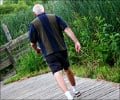Research presented at the American College of Rheumatology Annual Meeting in San Diego reveals that a self-directed walking program shows promise in easing joint stiffness in older women.

"We were interested in seeing if a physical activity program that is evidence-based for reducing joint pain, stiffness and fatigue in adults with arthritis might have similar benefits for women experiencing AI- associated arthralgia," says Kirsten A. Nyrop, PhD; research associate; Thurston Arthritis Research Center, School of Medicine; University of North Carolina at Chapel Hill; and lead investigator for the pilot study. "We were particularly interested in testing the feasibility and benefits of this program among older breast cancer survivors, because cancer is a disease of aging and physical activity may pose a special challenge for this age group."
The researchers tested the Arthritis Foundation's Walk With Ease self-directed walking program, which they adapted for breast cancer patients. Twenty women participated in the study. All were age 65 and older, had Stage I-III breast cancer, were on AI therapy, and reported joint pain or stiffness. The women followed the walking program for six weeks.
At the end of six weeks, 100 percent of the study participants said they would recommend the program to other breast cancer survivors experiencing joint pain or stiffness. All the participants also reported that they learned how physical activity could lessen their joint pain and stiffness, and that the program taught them how to safely engage in physical activity. In addition, 90 percent thought the program motivated them to be more physically active, explained how to overcome physical and mental barriers to exercise, and reported they were extremely confident that they would continue walking in the future. After six weeks of walking, the average joint pain scores among the participants decreased by 10 percent, fatigue decreased by 19 percent, and joint stiffness decreased by 32 percent. This led researchers to conclude that a moderate-intensity self-directed walking program is feasible for elderly breast cancer patients on AI therapy and can increase their engagement in regular walking or similarly safe physical activity.
"Physical activity is recommended for breast cancer patients - as it is for all adults - for both physical and mental health reasons," Dr. Nyrop explains. "It is important to offer breast cancer survivors physical activity options that are safe, enjoyable, and easy to do at home and on their own - with the promise of joint symptom relief that will encourage them to remain physically active in the long run."
The American College of Rheumatology is an international professional medical society that represents more than 9,000 rheumatologists and rheumatology health professionals around the world. Its mission is to advance rheumatology. The ACR/ARHP Annual Meeting is the premier meeting in rheumatology. For more information about the meeting, visit acrannualmeeting.org/ or join the conversation on Twitter by using the official hashtag: #ACR13
Advertisement
Abstract Number: 2091
Advertisement
Kirsten A. Nyrop1, Betsy Hackney1, Rebecca J. Cleveland1, Mary Altpeter1, Hyman Muss2 and Leigh F. Callahan3, 1University of North Carolina at Chapel Hill, Chapel Hill, NC, 2University of North Carolina at Chapel Hill, Chapel Hill, NC, 3University of North Carolina, Chapel Hill, NC
Background/Purpose: Joint pain/stiffness/achiness (arthralgia) is a common side-effect among postmenopausal women with breast cancer (BC) who are hormone receptor positive (HR+) for whom standard adjuvant endocrine treatment includes an aromatase inhibitor (AI). AI discontinuation due to side-effect severity is an estimated 20-32%. There is a need for effective alternative or adjunctive approaches to arthralgia management that enable BC survivors to remain on AI therapy while optimizing as pain-free a life as possible. This study investigates the feasibility of adapting and testing an evidence- based self-directed 6-week physical activity program (PA) for adults with arthritis - Arthritis Foundation's Walk With Ease (WWE) - among female BC survivors age 65+ on AIs who report joint pain.
Methods: Design: Mixed methods design: (a) semi-structured interviews (qualitative) to adapt the WWE program and (b) one-arm pre-post pilot test (quantitative) to gather preliminary data on program impact. Initial sample of 10 BC survivors completed questionnaires and interviews about barriers and facilitators to moderate intensity PA; findings were used to develop an insert (WWE-Breast Cancer) for the WWE workbook. New sample of 20 was recruited to participate in the WWE program, complete pre- and post-intervention questionnaires, and complete a post-intervention interview to refine the WWE- Breast Cancer insert. Recruitment: BC survivors age 65+ were recruited through the oncology clinic of a university-affiliated hospital. Eligibility: age 65+; Stage I-III breast cancer; currently on AI therapy; self- reported joint pain/stiffness; physician permission to engage in PA; English speaking. Measures: (1) walking - number of days per week and number of minutes per walk, and (2) visual analog scales (VAS) for joint pain, fatigue and stiffness. Statistics: t-test evaluation of changes in mean values.
Results: Total sample (N=30) - mean age 70 (range 65-87), 90% Caucasian, 30% < high school degree. Within the walking sample (N=20): 100% would recommend WWE to other breast cancer survivors experiencing joint pain or stiffness; 100% thought they had learned how joint pain or stiffness could be lessened by physical activity, and how to safely engage in moderate-intensity physical activity; 90% thought WWE had motivated them to become more physically active, and how to overcome physical and mental barriers to walking; and 90% were fairly to extremely confident they would continue walking. At 6 weeks, all three walking measures showed significant improvements: number of times increased by 1.9 (effect size = 0.68, p<0.001), number of minutes increased by 8.8 (effect size = 0.48, p<0.05), and total minutes per week increased by 62.6 (effect size = 0.53, p<0.001). Mean joint pain decreased 10% (p=0.63), fatigue decreased 19% (p=0.31), joint stiffness decreased 32% (p=0.07).
Conclusion: A moderate-intensity self-directed walking program is feasible for elderly breast cancer patients on AI therapy who have joint pain. The program significantly increased total walking time per week over a 6 week period and was perceived as informative and motivational.
Disclosures: K. A. Nyrop, None
B. Hackney, None
R. J. Cleveland, None
M. Altpeter, None
H. Muss, None
L. F. Callahan, None
Source-Newswise














